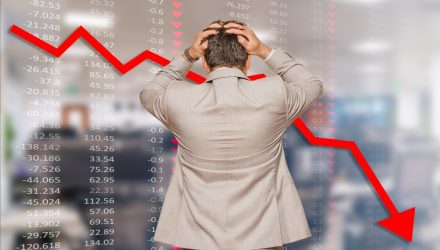While the markets have experienced a bout of wild swings, the lack of extreme volatility reflected by the CBOE Volatility Index and VIX-related exchange traded funds suggest that market fears have not peaked and the bottom may not have actually passed.
The iPath Series B S&P 500 VIX Short Term Futures ETN (NYSEArca: VXX) increased 4.6% and the ProShares VIX Short-Term Futures ETF (NYSEArca: VIXY) advanced 17.9% over the past month. Meanwhile, the CBOE Volatility Index was now trading around 28.8.
Since 1990, the Cboe Volatility Index, or so-called VIX, has averaged a level of 37 for a market bottoms, compared with its most recent level of around 32, Reuters reports.
Consequently, some warn that market fear has not peaked and stocks may have further to fall, even though the S&P 500 has already declined almost 20% from its record high, or is close to dipping into an official bear market.
“Sentiment is negative out there but there is no real fear, there is no sense of panic,” Kris Sidial, a co-founder at volatility arbitrage fund The Ambrus Group, told Reuters. “The one thing that you are not seeing is capitulation.”
The VIX measures the expectation of stock-market volatility or acts as a so-called fear gauge as expressed by options prices to hedge any further equity market swings. The gauge is also trading well above its long-term median level of 17.6.
Many market observers anticipate volatility to remain elevated as markets continue to cope with a hawkish Federal Reserve, four-decade high inflation, and geopolitical uncertainty due to the war in Ukraine.
Some have seen the VIX’s failure to cross well above the mid-30s as a potential sign that selling in the U.S > equities is not yet over, so many have curbed the urge to buy on the dips.
“I just don’t think we have seen that sort of event that marks a bottom,” Steve Sosnick, chief strategist at Interactive Brokers, told Reuters.
In comparison, the VIX surged to a closing high of 82.69 during the peak of the March 2020 COVID-19 pandemic selloff. The index also touched a high of 36.07 in 2018, when equities were within eyeshot of entering a bear market on concerns over tightening Fed policy. It also topped out at 80.86 during the Great Recession.
“I would love to see more panic and absolute flushing of this market,” Mike Vogelzang, chief investment officer at CAPTRUST, told Reuters. “I’d love to see VIX at 40 or 45.”
For more news, information, and strategy, visit ETF Trends.
